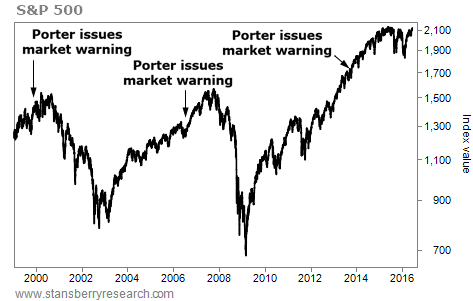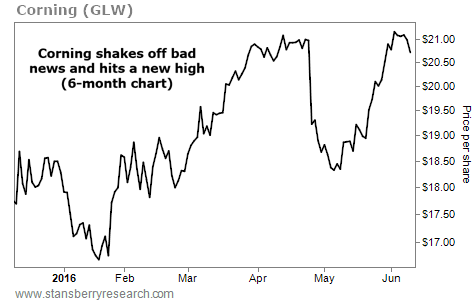| Home | About Us | Resources | Archive | Free Reports | Market Window |
You Probably Won't Listen to This Unpopular – but Important – AdviceBy
Friday, June 10, 2016
It's perhaps the most unpopular advice we give at Stansberry Research. It sparks as much angry feedback as anything we write.
I'm talking about short-selling.
For the uninitiated, short-selling means you profit when a company's share price falls. To open the trade, you borrow shares and sell them into the market. To close the trade, you buy back shares. (It may sound complicated, but in reality it's just as easy to do in your brokerage account as buying shares.)
Today, I want to take a step back and remind readers why we short... and why we don't worry about taking losses along the way...
We've been advocating shorting stocks as a form of "portfolio insurance" for years. Back in December 2006, Porter Stansberry explained...
As you can see, we do not use short-selling to make big money... but rather, to guard against broad market downturns. That's why we call it portfolio insurance. We measure success as managing to break even (or make a little money) with our short recommendations. Think about it: If you can break even on a series of trades that protect your overall portfolio from a broad market selloff, why wouldn't you? "But does it really work out that way?" you might be wondering. "Does the 'short-selling is portfolio insurance' strategy actually hold up?"
To answer these questions, let's take a look at how the overall market has performed since we launched our flagship product – Stansberry's Investment Advisory – back in 1999...
 There are two things to note here. First, there have been five broad market trends over the period we're evaluating: three bull markets and two bear markets. It's difficult to make money short-selling during bull markets... But when the market drops, you'll be glad you have that short exposure. Think of bull markets as periods when we're "paying premiums" on this portfolio insurance, while bear markets are when we "collect" on our insurance policies and reap the benefits of our short exposure.
Second, note that over this period, Porter's market calls tended to be early. In the current bull market, his June 2013 call was extremely early.
But when we turn bearish on the market, we don't sell everything and run for the hills. We simply pepper our portfolio with more short exposure than normal. Again, this protects our overall portfolio from a downturn.
The table below compares the annualized returns of our "hedged" portfolio (which includes long and short recommendations) to a hypothetical "long only" over each of these broad market cycles...
In total, our "insurance" is costing us less than one percentage point of annualized performance over the last 16-plus years, while drastically reducing our exposure to a broad market downturn. And you can see that having an active short portfolio as the market peaked in 2000 and again in 2007 boosted our overall gains.
Hopefully, you can see why we recommend short-selling as part of a broader strategy to protect yourself. And as the market continues to flash warning signs today (which you can read more about here and here), we believe that advice is more important than ever.
Regards,
Bryan Beach
Further Reading:
Learn more about the logistics of short-selling – and the types of stocks you should look to short – in this classic interview with master trader Jeff Clark from the Stansberry Research Education Center.
Short-selling is just one of two ways to profit from falling stocks. Read about the other way right here.
Market NotesTHE FUTURE IS BRIGHT FOR THIS MARKET LEADER Today, we're looking at a business that's benefiting from the "New Machine Age"...
This massive movement will take years – possibly decades – to unfold. And one company is driving this megatrend with products that you likely touch every day without realizing it.
We're talking about Corning (GLW). The $22 billion firm makes high-tech glass and fiber-optic cables. Its "Gorilla Glass" is used in 4.5 billion devices... including smartphones, tablets, laptops, and TVs. Its customers include some of the world's biggest technology companies, like Samsung, Nokia, Dell, HP, Toshiba, Motorola, and LG.
Corning shares rose more than 25% from January to April. But the company reported earnings that fell short of analyst estimates... and shares pulled back. Since then, Corning shares have recovered all of those losses and then some, recently hitting a new 52-week high. It's a perfect example of the power of investing in high-quality businesses when they go "on sale"...
 |
Recent Articles
|
|||||||||||||||||||||||||||||||||||||||||||||||||||



